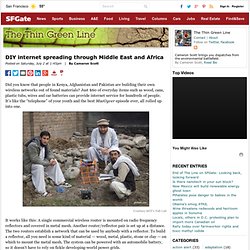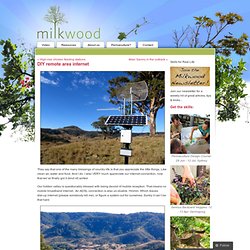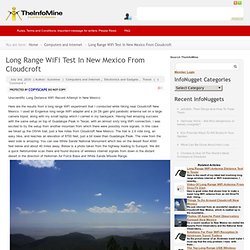

DIY internet spreading through Middle East and Africa. Did you know that people in Kenya, Afghanistan and Pakistan are building their own wireless networks out of found materials?

Just $60 of everyday items such as wood, cans, plastic tubs, wires and car batteries can provide internet service for hundreds of people. It’s like the “telephone” of your youth and the best MacGyver episode ever, all rolled up into one. Courtesy MIT’s Fab Lab It works like this: A single commercial wireless router is mounted on radio frequency reflectors and covered in metal mesh. Another router/reflector pair is set up at a distance. The goal is simply internet access for all. It’s an open-source project, so if you’re interested in building a DYI network here in the shadow of Silicon Valley, just hit up the wiki. Hat tip to Fast Company for this awesome story. Afghanistan's Amazing DIY Internet. The Afghan city of Jalalabad has a high-speed Internet network whose main components are built out of trash found locally.

Aid workers, mostly from the United States, are using the provincial city in Afghanistan's far east as a pilot site for a project called FabFi. It's a broadband apart from the covert, subversive "Internet in a suitcase" and stealth broadband networks being sponspored by the U.S., aimed at empowering dissidents, but the goal isn't so different: bringing high-speed onilne access to the world's most remote places. Residents can build a FabFi node out of approximately $60 worth of everyday items such as boards, wires, plastic tubs, and cans that will serve a whole community at once. While it sounds like science fiction, FabFi could have important ramifications for entire swaths of the world that lack conventional broadband.
FabFi is an open source project that maintains close ties to MIT's Fab Lab and the university's Center for Bits and Atoms. [Images: Courtesy FabFi] DIY remote area internet. They say that one of the many blessings of country life is that you appreciate the little things.

Like clean air, water and food. And I do. I also VERY much appreciate our internet connection, now that we’ve finally got it (kind of) sorted. Our hidden valley is questionably blessed with being devoid of mobile reception. That means no mobile broadband internet. Our hidden valley, showing Nick's family's farm (next door to Milkwood) Wait. Hey – that’s not so bad! Take a breath, hold it, and close your eyes. Now multiply this experience by every. time. you. click. on. anything. So, for the sake of our business, our blog, our students and our sanity, we really needed to figure out how to get faster internet to our farm.
It turned out that there was mobile reception on top of the nearest mountain, which in turn, happened to be on our farm. Actually, no. We went looking for remote area internet setups that could do this. How-To: Build a WiFi biquad dish antenna. Long Range WiFi Distance Test New Mexico. Unscientific Long Distance WiFi Record Attempt In New Mexico.

Here are the results from a long range WiFi experiment that I conducted while hiking near Cloudcroft New Mexico. I used an Engenius long range WiFi adapter and a 24 Db gain grid parabolic antenna set on a large camera tripod, along with my small laptop which I carried in my backpack. Having had amazing success with the same setup on top of Guadalupe Peak in Texas, with an almost sixty long WiFi connection, I was excited to try the setup from another mountain from which there were possibly more signals. In this case we hiked up the OSHA trail, just a few miles from Cloudcroft New Mexico. The trail is 2.6 mile long, an easy hike, and reaches an elevation of 8700 feet, just a bit lower than Guadalupe Peak. The photo below was taken at Sunspot New Mexico, about 15 miles from the OSHA trail and shows the desert down below.
Above is a photo of one of the telescopes at Sunspot New Mexico. Texas Long Range WiFi Record Attempt.